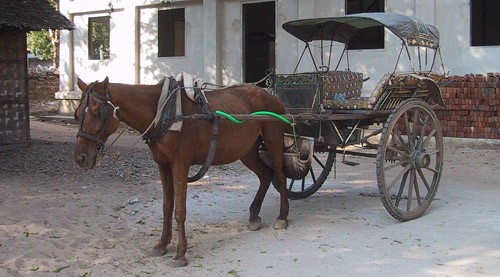Burmese Ponies, also known as Shan Ponies, originated in the
Shan state of Eastern Burma, where they are bred today by local tribes. They
are similar to Bhutia, Spiti, and Manipuri ponies of the Himalayan Mountains,
suggesting these breeds have a similar origin, most likely deriving from the
Mongolian horse and other Eastern breeds.
Burmese ponies may reach 13 hands high, and are brown, bay,
chestnut, black or gray in color. They are not particularly pretty horses,
having been bred for function rather than looks. The head usually has a
straight profile, the neck is muscular. The back may be long, and the croup is
sloping. The ponies do not have very pronounced withers, and a rather upright
shoulder, creating a short stride (which is desirable in mountainous terrain,
even if considered a fault in a riding horse). The chest is deep and wide, the
hooves small and hard, and the legs are fine, yet strong. They tend to be
sickle hocked and the forearms and gaskins are poor. The Burmese Ponies are
sure footed, tough, have excellent endurance, are of a quiet temperament, are
willing. They are not fast and are not particularly athletic, but they do jump
well. They are easy keepers and able to live in harsh environmental conditions.
The Burmese is well-adapted to its mountainous environment,
being very sure-footed, tough, with great stamina and resistant to the harsh
environment. This trait has made them extremely popular as trekking and pack
ponies. They have a very quiet temperament and a willing nature, making them
popular mounts for novices and children. At one time the Burmese were used as
polo mounts for British colonials. However, they are not incredibly fast or
athletic, so this was most likely because they were the only mounts available
at that time.
